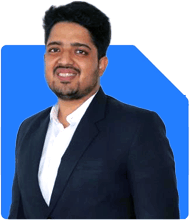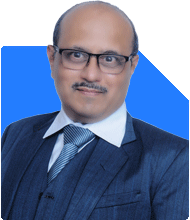Ramalingam Kalirajan |10872 Answers |Ask -Follow
Mutual Funds, Financial Planning Expert - Answered on Oct 24, 2024
He has an MBA in finance from the University of Madras and is a certified financial planner.
He is the director and chief financial planner at Holistic Investment, a Chennai-based firm that offers financial planning and wealth management advice.... more

I am 38 years old and invested in MF through SIP. My monthly SIP are Parag Parikh flexi Cap- Rs. 5000 since 4 years, Mirae asset Large and Midcap- Rs. 5000 since 4 years, Quant Small Cap- Rs. 3000 since 1 year, Nippon India Small Cap - Rs. 2000, Quant Mid Cap- Rs. 5000 since 6 months, Axis Bluechip - Rs. 5000 since 4 years. Further I have started STP in Motilal Oswal Large and Midcap, Motilal Oswal Midcap and JM financial Flexi Cap. STP amount is Rs. 500000 Lakh in each Mutual fund for 2 years then hold for minimum period of 20 years. How much corpus I may get at the end of 20 years. Any modification is required, please suggest.
Current SIP Investments
You have SIPs in the following categories:
Flexi-Cap Fund: Rs 5000/month for 4 years
Large and Mid-Cap Fund: Rs 5000/month for 4 years
Small-Cap Fund: Rs 3000/month for 1 year and Rs 2000/month for 6 months
Mid-Cap Fund: Rs 5000/month for 6 months
Blue-Chip Fund: Rs 5000/month for 4 years
Your SIPs seem to be a mix of long-term, high-growth, and stable funds. Flexi-cap and blue-chip funds provide stability, while small-cap and mid-cap funds offer potential for higher growth.
Systematic Transfer Plans (STP)
You’ve allocated Rs 5 lakhs each into three funds through STPs, with plans to hold these investments for 20 years. This approach helps reduce market timing risk by gradually transferring lump-sum amounts into the market, which can be very beneficial in volatile conditions.
The following funds are part of your STP strategy:
Large and Mid-Cap Fund
Mid-Cap Fund
Flexi-Cap Fund
Holding these for 20 years should yield solid returns, given the equity markets' tendency to grow over longer horizons.
Estimating Corpus Over 20 Years
Projecting the exact corpus after 20 years can depend on many factors, such as market conditions and fund performance. However, based on historical average returns of 12% to 15% for equity mutual funds over long periods, you can expect a considerable corpus from both your SIPs and STPs.
The growth in your portfolio can be significant, particularly with regular contributions through SIPs and the compounding effect over time. The final value could comfortably exceed several crores, provided you stay invested through market cycles. This would give you a strong financial foundation for future needs, such as retirement or family obligations.
Portfolio Assessment
Let's assess your portfolio from various angles:
1. Diversification
You have diversified across multiple categories: flexi-cap, small-cap, mid-cap, and large-cap funds. This is crucial to reduce risks associated with any one segment underperforming. However, you have invested in two small-cap funds, which can increase portfolio volatility. You may consider reducing exposure to one small-cap fund to avoid overconcentration in this high-risk category.
2. Investment Horizon
Your long-term investment horizon of 20 years works in your favour. Equities tend to outperform other asset classes over such periods, despite short-term fluctuations. Your current strategy aligns well with long-term wealth creation goals.
3. STP Strategy
STPs are a great way to mitigate market risk. However, it’s essential to review the performance of your STP funds regularly to ensure they meet your expectations. While you’ve chosen good categories, some active monitoring is needed.
4. Mid-Cap and Small-Cap Exposure
While mid-cap and small-cap funds provide higher growth potential, they are also more volatile. Having both SIPs and STPs in mid-cap and small-cap categories is an aggressive approach. It’s important to balance this with more stable funds such as large-cap or flexi-cap funds.
5. Risk and Volatility
Given your age, it’s reasonable to have higher equity exposure. However, it’s important to keep an eye on the overall risk profile of your portfolio. If markets become highly volatile, your small-cap and mid-cap funds may experience more significant corrections. Having more exposure to large-cap and flexi-cap funds could help smoothen the volatility.
Suggestions for Modifications
After analysing your portfolio, here are some potential modifications:
Reduce Small-Cap Exposure: You currently have two small-cap funds. Consider reducing one of them to manage risk better. Small-caps are high-risk, high-reward, and too much exposure can increase your portfolio’s volatility. Redirect those funds to large-cap or multi-cap categories.
Increase Allocation to Large-Cap: You may benefit from increasing your allocation to large-cap funds. Large-cap funds are more stable and offer consistent growth. This will help balance out the volatility from your small and mid-cap funds.
Consolidate Mid-Cap Funds: Since you already have significant exposure to mid-cap funds, consolidating into one mid-cap fund might simplify your portfolio and make it easier to manage. Keeping too many similar funds doesn’t necessarily increase diversification, but it does increase complexity.
Review the STP Funds: Regularly review your STP investments and their performance. Ensure that the large-cap, mid-cap, and flexi-cap funds you’ve chosen continue to perform well over the long term. If necessary, switch to better-performing options within the same categories.
Benefits of Actively Managed Funds over Index Funds
You haven’t mentioned index funds in your portfolio, which is a good thing. Actively managed funds often outperform index funds over long-term periods, particularly in the Indian market where active managers can exploit market inefficiencies. Index funds lack flexibility and might not deliver optimal returns, especially during market downturns. By staying with actively managed funds, you are giving your portfolio the chance to beat the broader market.
Why Regular Funds Through a Certified Financial Planner Are Better
You have not indicated whether you are using direct funds or regular funds. If you are using direct funds, you might want to reconsider. While direct funds may seem appealing due to lower expense ratios, they lack professional guidance. Investing through a Certified Financial Planner (CFP) who can actively manage your portfolio adds more value. A CFP can help you with ongoing portfolio reviews, goal planning, and strategic modifications when needed. The cost of a regular plan is often worth the benefits of expert advice and regular monitoring.
Taxation Considerations
Mutual fund taxation has evolved, and it's important to keep the new rules in mind when planning long-term investments:
Long-Term Capital Gains (LTCG) on equity mutual funds are taxed at 12.5% for gains above Rs 1.25 lakh.
Short-Term Capital Gains (STCG) are taxed at 20%.
These taxes will impact your returns, so you should factor them into your long-term planning. Ensure that you don’t sell units unnecessarily before the 12-month holding period to avoid higher taxes.
For debt mutual funds, both LTCG and STCG are taxed as per your income tax slab. However, given your focus on equity funds, the primary concern will be equity taxation.
Final Insights
You have built a well-diversified portfolio that aligns with long-term growth and wealth creation. While your SIPs and STPs are on track, making a few tweaks can help optimise your returns and manage risk more effectively.
Consider reducing your small-cap exposure, increasing large-cap allocations, and consolidating your mid-cap investments. Regularly reviewing your STP funds will ensure they continue to perform as expected over your investment horizon.
Remember, investing through a Certified Financial Planner adds significant value over time by providing expert guidance and helping you stay on track with your financial goals.
Best Regards,
K. Ramalingam, MBA, CFP,
Chief Financial Planner,
www.holisticinvestment.in
https://www.youtube.com/@HolisticInvestment
You may like to see similar questions and answers below
Nikunj Saraf | Answer |Ask -Follow
Mutual Funds Expert - Answered on Sep 27, 2022
Hardik Parikh | Answer |Ask -Follow
Tax, Mutual Fund Expert - Answered on Apr 19, 2023
Ramalingam Kalirajan |10872 Answers |Ask -Follow
Mutual Funds, Financial Planning Expert - Answered on Apr 30, 2024
Nitin Narkhede | Answer |Ask -Follow
MF, PF Expert - Answered on Sep 13, 2024
Milind Vadjikar | Answer |Ask -Follow
Insurance, Stocks, MF, PF Expert - Answered on May 06, 2025
Radheshyam Zanwar |6735 Answers |Ask -Follow
MHT-CET, IIT-JEE, NEET-UG Expert - Answered on Dec 06, 2025
Dr Nagarajan J S K |2576 Answers |Ask -Follow
NEET, Medical, Pharmacy Careers - Answered on Dec 06, 2025
Mihir Tanna |1090 Answers |Ask -Follow
Tax Expert - Answered on Dec 06, 2025
Ramalingam Kalirajan |10872 Answers |Ask -Follow
Mutual Funds, Financial Planning Expert - Answered on Dec 06, 2025
Radheshyam Zanwar |6735 Answers |Ask -Follow
MHT-CET, IIT-JEE, NEET-UG Expert - Answered on Dec 06, 2025
Radheshyam Zanwar |6735 Answers |Ask -Follow
MHT-CET, IIT-JEE, NEET-UG Expert - Answered on Dec 06, 2025
Radheshyam Zanwar |6735 Answers |Ask -Follow
MHT-CET, IIT-JEE, NEET-UG Expert - Answered on Dec 06, 2025
Dr Dipankar Dutta |1837 Answers |Ask -Follow
Tech Careers and Skill Development Expert - Answered on Dec 05, 2025
Dr Shyam Jamalabad |108 Answers |Ask -Follow
Dentist - Answered on Dec 05, 2025
Dr Shyam Jamalabad |108 Answers |Ask -Follow
Dentist - Answered on Dec 05, 2025






























